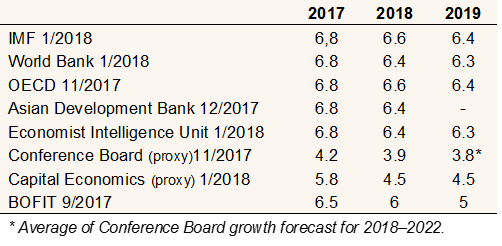BOFIT Weekly Review 04/2018
Forecasts of major international institutions see China sustaining strong growth in coming years
Following the World Bank's lead earlier this month, theInternational Monetary Fund released its own updated global economy forecast this week. Both forecasts revised their China 2018 growth outlooks up slightly on, among other things, recovery in external demand. The medium-term risks are trending upward with the financial sector's increasing vulnerability and rising trade barriers around the world. The IMF slightly raised its global economy forecast, and now expects growth of 3.9 % p.a. in 2018 and 2019.
Other forecasting institutions generally agree that Chinese growth will remain robust in coming years and that China will make its long-term policy goal of doubling real GDP between 2010 and 2020. At the moment, this would require average growth in the range of 6.2–6.3 % p.a. up to 2020. The EIU had earlier expected that China's leaders would have already shifted their policy emphasis to getting debt under control, with growth slowing significantly in 2018–20. The new EIU forecast sees lower growth shift coming after 2020. Investment banks that monitor China expect growth to average 6.5 % p.a. in 2018. Forecasts range from 5.8 % to 6.9 %.
Even if official figures show that China is on track to hit its GDP growth target, two international forecasting bodies, the Conference Board and Capital Economics, point out that China's methodology for calculating GDP growth is faulty and fails to reflect true economic trends. Both forecasters release alternative estimates for the Chinese economy that suggest significantly lower growth than official estimates. The alternative indicators, in particular, diverge from official GDP growth figures in the 2015–16 period, when also many other measures of China's growth indicated much lower readings.
GDP growth forecasts for China, %
